EBOOK
Smart Email Capture Strategies
Published: Jul 9, 2019
As a vital part of your overall customer acquisition plan the humble email capture strategy is often overlooked. This is despite the fact that securing an email address from a prospective customer opens the door to a world of opportunity when it comes to your email and digital marketing efforts.
Many marketers are still relying on a ‘one size fits all approach’ that doesn’t quite meet the rapidly rising consumer expectations around website personalization and privacy. In this guide, we take a look at new ways brands can approach email capture and lead generation to ensure a better customer experience in a newly privacy-conscious world.
Email Capture: The Current Landscape
A successful email capture strategy is about appealing to the right people, and making sure the leads that you generate are real and valuable opportunities. Sounds pretty simple, but having created thousands of email capture campaigns for our clients, we’ve found that appearances can be deceptive.
So what are the key challenges facing marketers when it comes to email capture?
One of the biggest challenges facing marketers is the rise in consumer awareness of and expectations around privacy when it comes to their data. In Europe, the implementation of GDPR legislation in May 2018 saw the average marketer lose 23% of their database, and more than one-third lost over 30%.
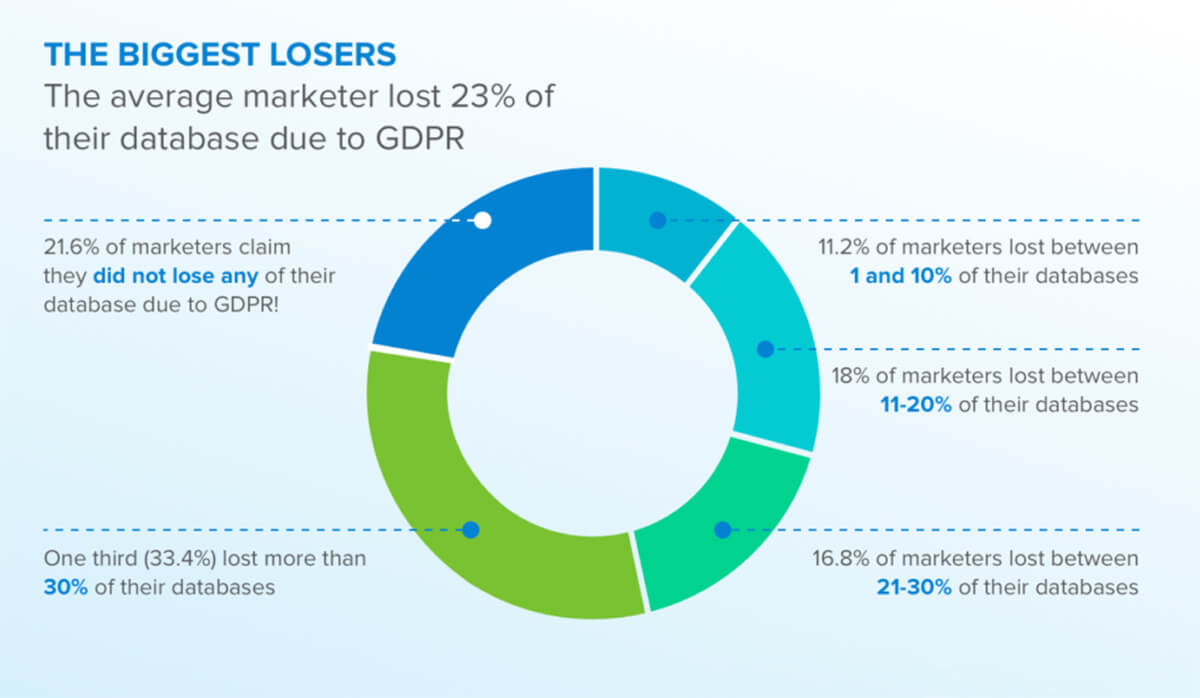
The good news? Marketers have been forced to focus on engagement during the email capture process, leading to better quality, more engaged leads.
Already we’ve seen unexpectedly strong recovery from those affected by GDPR, with retail marketers reporting a recovery to 101% of their pre-GDPR levels.
Other industries have struggled more though, with travel marketing databases still only at 74% of their previous levels. It’s also worth noting that larger businesses, whilst harder hit by the legislation, have recovered at a higher rate than smaller ones.
Though this recovery is generally better than many had expected, there’s still a lot of room for improvement. For the last year, email capture strategies have been focused primarily on recovering numbers whilst maintaining compliance with GDPR. Now, as marketing database levels begin to return to normal, there’s an opportunity to re-evaluate what successful lead generation looks like.
Aside from the wider challenge of privacy, and laws like GDPR, there are a few challenges closer to home that marketers also need to consider:
- Email capture campaigns can be too obtrusive, displaying at inopportune moments is more of an annoyance than a benefit to your visitors.
- At the other end of the scale, many strategies aren’t obtrusive enough (think about newsletter sign-up forms hidden in website footers!).
- In today’s content-heavy world, the offer needs to be compelling – do your visitors really want another newsletter in their inbox?
- But at the same time, discounts, while compelling can create all sorts of problems with customer expectations, as well as impacting your margin.
- Today’s approach to email capture does what it says on the tin – captures emails. Is this really enough data to create a personalized experience for your visitors?
Consider this ebook your guide to a new era of email capture. By taking a smarter, more thoughtful approach to the process, utilizing website personalization, and offering customers opportunities at the right moment, and in the right way, you can bring in genuinely useful leads from customers who are excited to hear from you!
The best way to achieve this? Follow the four ‘P’s of excellent email capture…
1. Presentation
Where and how you ask for a user’s information, and which information you ask for, is the core foundation upon which successful customer database growth is built. Regardless of your other efforts to improve engagement and sign-up rates, if the customer doesn’t have the opportunity to share their data with you, you aren’t going to get it.
Making sure that your email capture opportunity is presented in a way that is accessible and appealing is your first priority, then. As such, the presentation includes a number of things.
First, there’s the seemingly simple question of what information you ask for. The best email capture strategies can assist you in gathering a wealth of information from prospective clients, and allows you to better target your messaging in the future.
Name, age, gender, income – all of these can be incredibly useful information for a marketer. They also require a lot of different fields that the customer needs to fill in, and this sort of commitment is frequently more than they are willing to give.
A better approach is to gather as much data as possible elsewhere and keep your form focused on as few details as possible.
Most lead capture forms will have one simple box – email. After all, email is the only piece of data you need to guarantee a second chance to engage your customers. But you could be making your lead generation forms work harder with a few simple tweaks.
The key to gathering extra data is by making the sharing process as easy, and as standardized as possible. Yieldify has recently added the ability to include dropdown menus in lead capture forms. This offers an added layer of insight for marketers in a way that makes things easier for both parties – less typing for the customer, and simple, easily actionable data for the marketer.
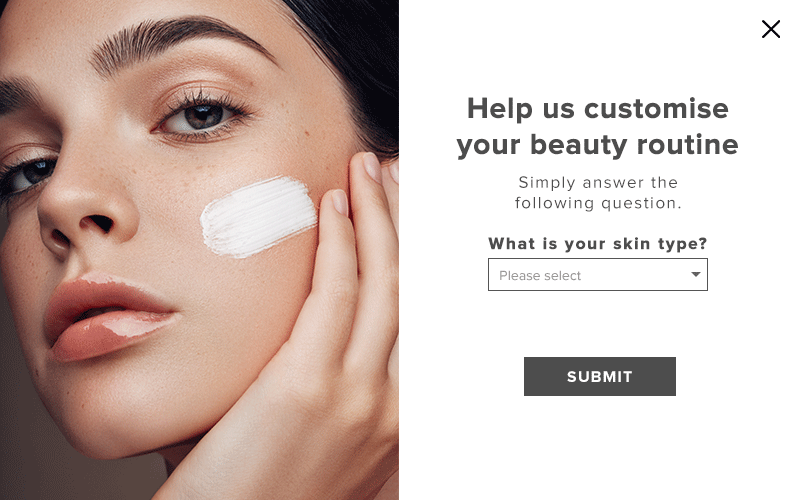
Once you’ve decided what will be on your form, you need to decide how to present it. Many companies feature a simple lead capture form in the footer of their website – an easy and simple positioning that ensures visibility on every page within their site.
The downside of this is that, as we’ve mentioned, it isn’t a particularly active form of email capture. It relies on the customer scrolling down, seeing a static box in the corner of their screen, and choosing to engage with it.
At the other end of the scale, there’s the overlay option or ‘pop up’. Poorly implemented overlays can be jarring for users and have the potential to compromise your brand, so it’s important to be really careful with how you present these to your visitors.
But how? Enter behavioral segmentation.
Understanding the right moment to present an overlay to visitors is vital – examining your data will help you identify a few likely ‘moments of truth’ along the customer journey where it makes the most sense to target your visitors.
Then once you understand more about your visitor behavior you can build an engaging email capture campaign based on this, for example, the number sessions your visitor has had, or if they’re showing exit intent. And that brings us nicely along to our next ‘P’…
2. Picking your moment
One of the most common trends in lead capture notifications is for pop-ups that open immediately upon entering the site. This is a great example of an aggressive campaign that can often do more damage than good. Potential customers, who are perhaps visiting the website for the first time, are faced with an intrusive notification that blocks their ability to navigate the site before they’ve even had a chance to decide if they’d like to explore further.
Rather than leap at the first opportunity to sign your customers up, consider the customer journey, and how each customer’s intent varies from page to page throughout your site.
On your homepage, a viewer could have any number of goals – many will be first-time visitors looking to see what you have on offer – hiding this behind a pop-up can be off-putting. Once they’ve selected an item or product to look at in more detail, there’s a clearer idea of their intent. If they click to put an item in their basket, there’s more understanding and opportunity still.
The further down the customer journey you place your call to action, the more committed and thus valuable a customer you have. You’ve also picked up a lot of data about that customer which you wouldn’t have had if you asked for their email on their arrival. Clothes size, preferred holiday destination, even a sense of income – all these can be gathered from the customer journey.
Travel brand Thomas Cook Airlines considered customer intent when placing an email capture strategy on their website. With Yieldify’s help, the brand implemented a notification that displayed when the customer showed intent to leave.
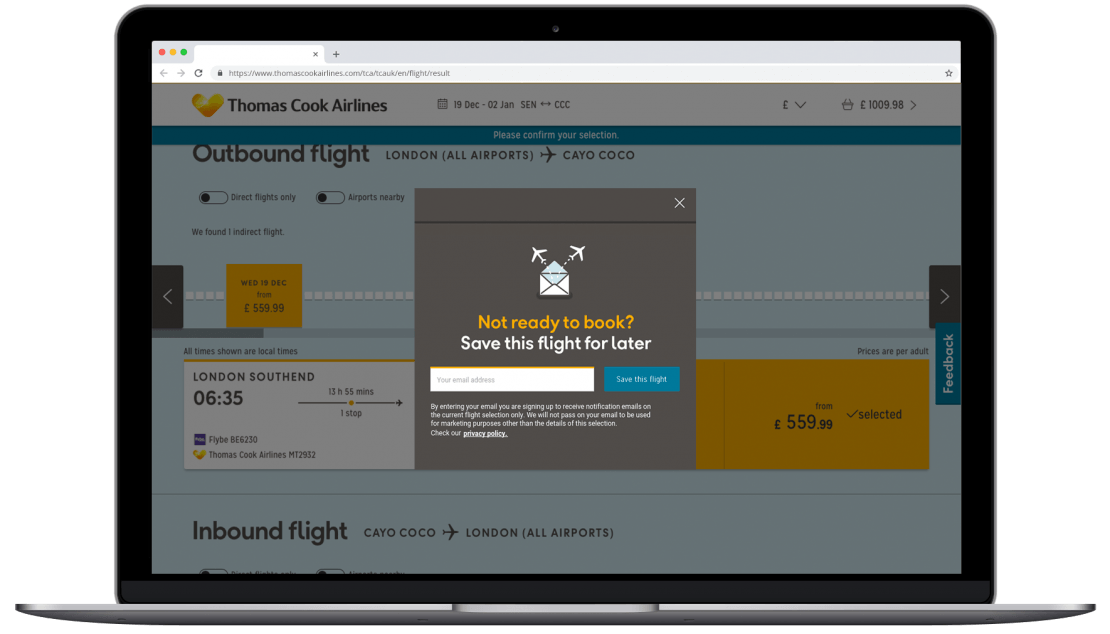
By offering customers a chance to save the flight they’d shown interest in, Thomas Cook Airlines both offered a useful service and provided a clear opt-in to receive remarketing for said flight, or other products like it, at a later point – a win-win for both customer and business.
Occasionally asking a visitor for data upfront can work – particularly for businesses where a personalized approach is the main USP. Firstleaf Wine Club want to ensure its visitors are able to discover the best wines for their tastes, and it uses a smart strategy to do this – a quiz!
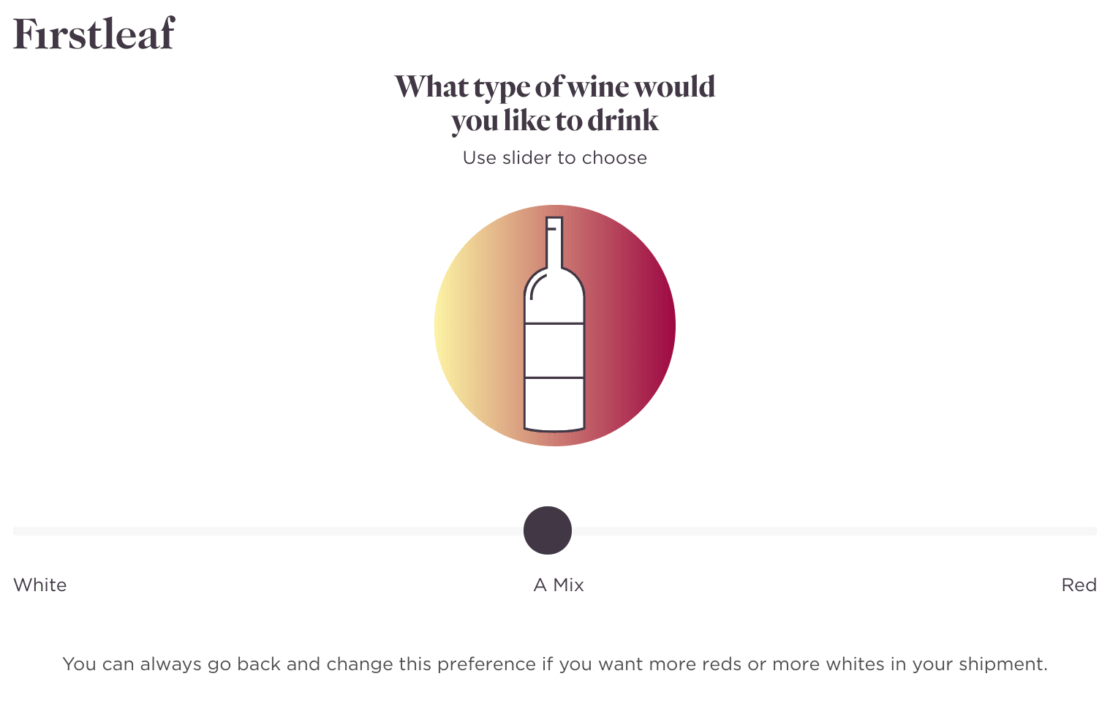
Covering preferred color, countries of origin, and more visitors get access to the full personalized recommendations in exchange for their email address.
By taking a fun, engaging, and above all useful approach to data capture Firstleaf are able to gather more insight than a single box for an email address could provide, meaning more data that the business could use to personalize future experiences. And this, really, is the stage that will mark the new era of lead generation out…
3. Personalization
Now more than ever we have the opportunity to personalize our marketing approaches. This obviously includes using the data we have to make sure that emails and newsletters are catered to the individual’s needs and interests – but it extends also to the initial moves we make to secure that data.
Personalization offers us the ability to capture leads in a way that makes the customer confident they’ve made the right decision in sharing their data.
A simple version of this is acknowledging whether the customer is new to the site, or a returning visitor. When Marks & Spencer upgraded its website it ensured that new customers could be greeted appropriately whilst returning visitors were recognized and offered an opportunity to re-engage with the new website:
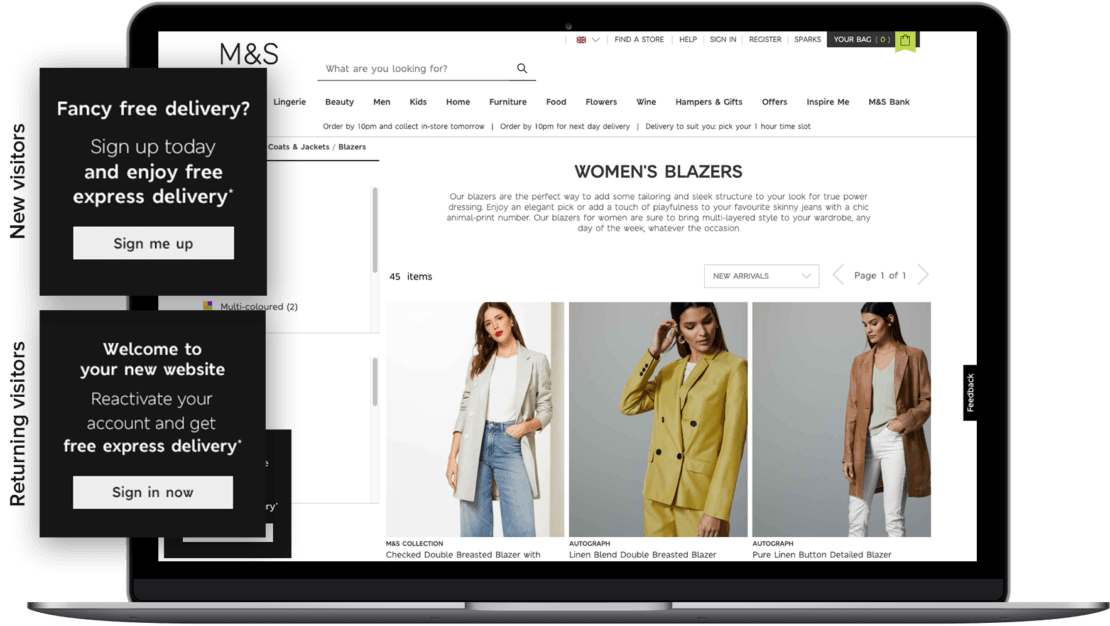
Personalization prior to sign-up can take place just by acknowledging the smallest of things, like the type of device being used to access the website. An email capture notification that is catered to customers using their mobile device to browse the site will be easier to use and thus more likely to yield results than a one-size-fits-all notification.
A great format to use for mobile devices is the floating button as it accounts for the lack of real estate available on smaller screens, and it’s also going to garner interest from those with intent since visitors need to click to interact. Learn more about floating buttons in this blog post.
4. Provocation
When customers are hesitant to share their data with you, offering a small incentive is often the final touch that can provoke action. In fact, offers, deals, and news of sales are frequently the provocation that helps bring in new leads by the droves.
A DMA report suggests that these represent the reasons for 60% of newsletter sign-ups. Our own data shows that post-GDPR while offering an incentive was one of the top tactics used by marketers seeking to rebuild their customer database, it was slightly edged out by sign-ups without incentives.
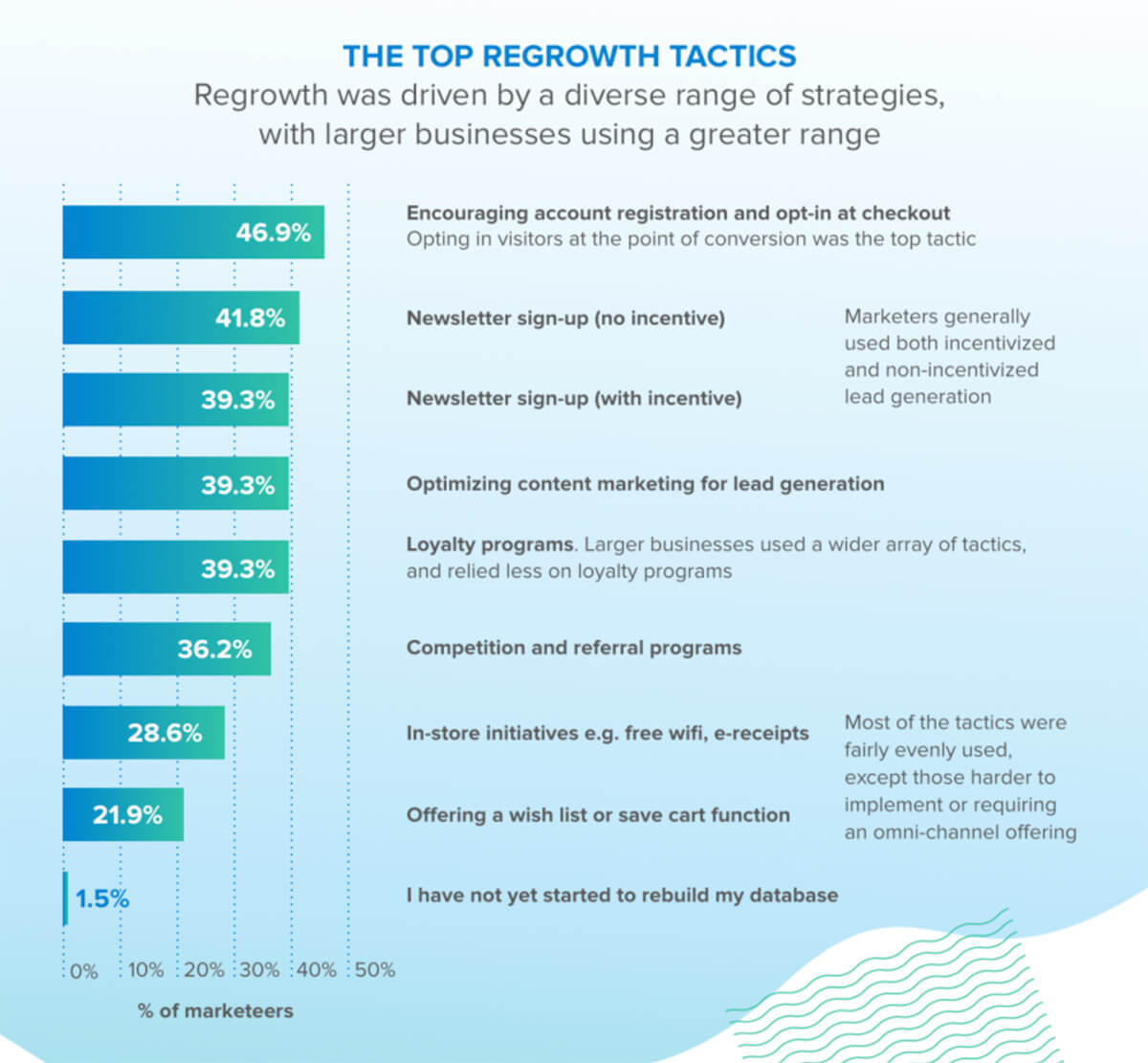
This is important to recognize, as it means you won’t always need to offer discounts or immediate incentives in order to achieve your email capture goals. In fact, in many cases, teasing promises of exclusive news and future offers will be enough to draw customers in – particularly those already interested in your brand.
When you do need to offer a more immediate incentive for email capture, be aware of the options available to you. A content tease is often a good way to bring in completely new customers. Think of Firstleaf’s quiz, the results of which were only revealed after an email address had been offered up. Or if you are going to offer an incentive you can again leverage behavioral segmentation, or triggering based on basket value to ensure you’re only targeting the visitors with the highest potential and value.
Gaming site Bethard drew in new customers with a subtle notification that alerted new customers to a deal that would give them free credit to start their betting with.
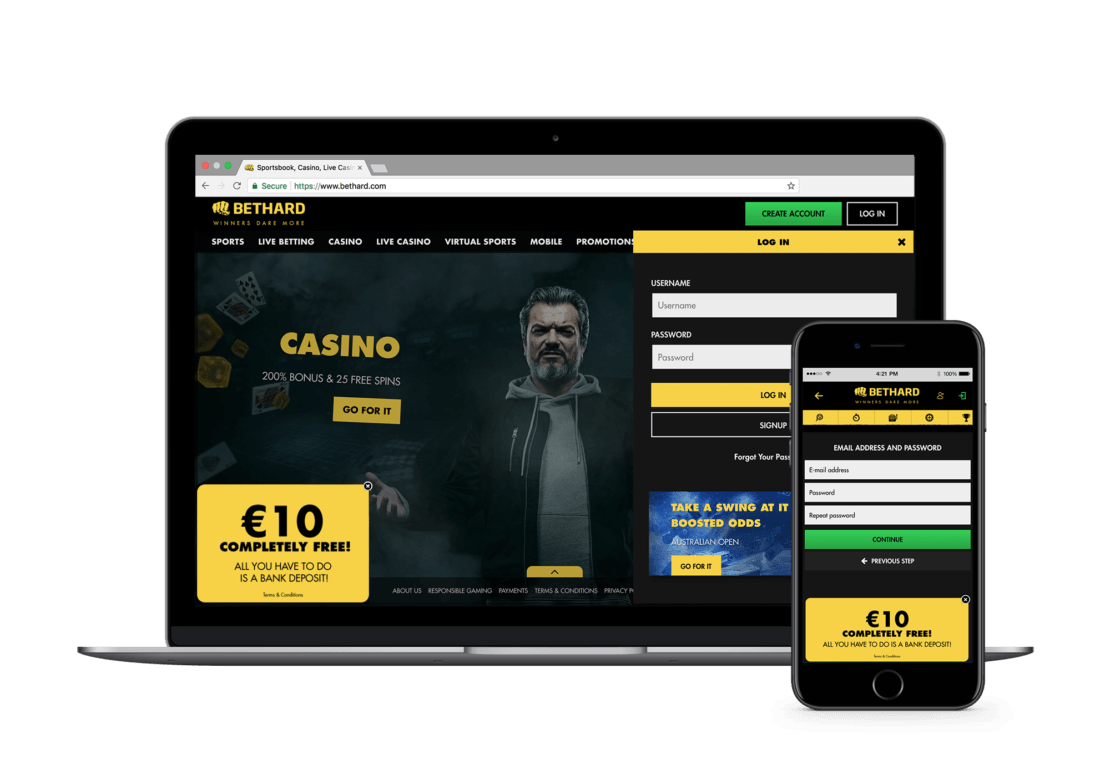
The campaign encouraged customers to make a deposit, which would give them an extra €10 credit for free. By drawing customers in first with a deal, that then committed them to engage directly with the site, the campaign provided an uplift in deposits of 23% and, in doing so, generated plenty of leads as well.
There are plenty of other ways to use incentives to provoke engagement from customers. New customers can often be signed up with immediate money-off deals, or promises of free shipping for members. Existing users can be brought into the lead generation fold with notifications alerting them to referral systems, through which they can earn rewards for introducing friends as new customers.
Smart Email Capture: In Conclusion
Utilizing the four ‘P’s is key to a savvy, flexible email capture campaign. Clear, simple, and unobtrusive presentation, picking the perfect moment to engage, personalizing the approach, and provoking the customers to action with the right incentives.
These are the ways you can separate yourself from your competitors and ensure every customer visiting your business’s website is excited to sign up for whatever you are offering.
And if you’re ready to start giving some of these strategies a try, why not speak with one of our experts? Click here to book your appointment!